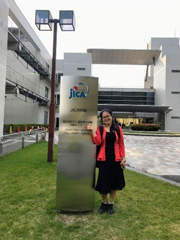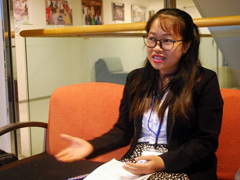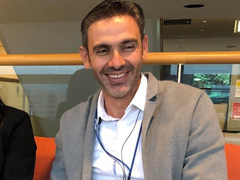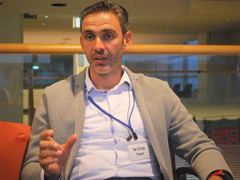The Development Studies Program offered by JICA, called the JICA-DSP, aims to offer global students a unique opportunity to imbibe Japan’s development experiences and international cooperation values. Through this program, JICA offers various types of educational content to participants, including the video teaching material “Seven Chapters of Japanese Modernization,” in collaboration with Open University of Japan.
In a candid conversation, Ms. Ly Soknay from Cambodia and Mr. Samer Zydia from Syria, participants of JICA-DSP, share their experience with the video teaching material.

Name: Ly Soknay
Country of Origin: Cambodia
Faculty and University: International Education Development Program, Graduate School of Humanities and Social Sciences, Hiroshima University
JICA Course: Improvement in Children’s Learning (JFY2019)

Before coming to Japan to be a part of the JICA-DSP, Ly worked as a Chemistry teacher at the Samdachme High School in Cambodia. Ly’s reasons for choosing Japan and JICA-DSP resonate with most of our participants. Ly has always been fascinated by Japan’s culture, and therefore applying for JICA-DSP was a no-brainer! She says, “Japan is a wonderful country, and I’ve always loved its philosophies, the food, and even the television shows! I selected JICA-DSP because the workshops here are of excellent quality and introduce various new teaching methods.”
Ly has some interesting observations about the teaching material. She mentions that she learnt how Japan adopted the global education system but put its unique spin on it; and the fact that this was explored in detail in the online course made it all the more insightful. She finds the chapter that dealt with the phase-wise modernization of the education system in Japan most fascinating. She says, “In Chapter 5: Educational development and modernization in Japan, we got to know in detail about the different stages of evolution of modern education in Japan. The chapter also shed light on how the post–World War II evolution of the Japanese education system was influenced by several different countries.”

Talking about her future plans after going back to her home country and applying her learnings from the course, Ly remains quite hopeful. She plans to use her learnings to improve the quality of education in Cambodia, especially the secondary school education. She adds that she also intends to introduce the online education system at her workplace in her country.
Ly concludes by talking about her experience with JICA as a whole, and what role she expects JICA and Japan to play in the future world. She says, “JICA has fulfilled all my expectations; all the programs and workshops have helped me immensely in understanding Japanese culture and education.” Ly believes that the educational material will also certainly help her to apply her learnings in her country in the future, and hopes that Japan continues to help developing countries like Cambodia.

Name: Samer Zydia
Country of Origin: Syria
Faculty and University: Transdisciplinary Science and Engineering Program, Graduate school of Advanced Science and Engineering, Hiroshima University
JICA Course: Japanese Initiative for the future of Syrian Refugees (JISR) (JFY2019)
Before coming to Japan, Samer completed a bachelor degree in architecture in Damascus University and a Master's degree in Housing rehabilitation and historical site planning, then worked as a Senior Project Architect at the Architecture Department of the Idea Design Office. Talking about his motivation towards global studies, Samer says, “My country, Syria, has been ridden with conflict since the past 10 years. It is crucial for me to understand the cause of such a crisis. And, to understand this situation from different perspectives, it is important to draw parallels with other countries.”

According to Samer, the part of Asia he hails from considers Japan the first real “developed” country in Asia, and there is actually a lot in common between the two countries. Samer was also fascinated by how Japan recovered after World War II and wanted to learn more about it. “Being an architect, I am interested in reconstruction and restoration studies,” he says, “and I highly recommend JICA-DSP, because the quality of science and education is top-notch.”
Regarding the educational material, Samer says that it was extremely informative and explained the modernization of education in Japan and how it occurred in three stages: evaluation of systems, sending diplomats to study western culture, and promoting local talent. He also finds this three-stage approach quite fascinating. He says, “I found Chapter 5: Educational development and modernization in Japan particularly insightful. I learned in detail about the different stages of the evolution of modern education in Japan, including the three-phased Meiji Restoration period and the changes that occurred post-World War II.”
When asked to share his future plans after going back to his home country, Samer is quite overwhelmed. He plans to stay in Japan for the next couple of years and learn even more about the culture, the people, and the technology here. As an architect, he has found this program extremely useful, and hopes to apply his learnings from this field to invest in the future of his country. “Technology has opened a lot of doors for us, and I look forward to bridging the gap in education between my country and Japan,” says a bright-eyed Samer.
Samer came to Japan a year ago and was able to interact with the people here and understand the Japanese culture—a one-of-a-kind experience for him. He shares some final thoughts on how JICA and Japan can influence the world positively in the future, and why the JICA-DSP is highly recommended. “I’m thankful to JICA for everything, right from the application process to the smooth functioning of the courses,” he concludes, “I look forward to collaborating with JICA and Japanese universities in the future.”